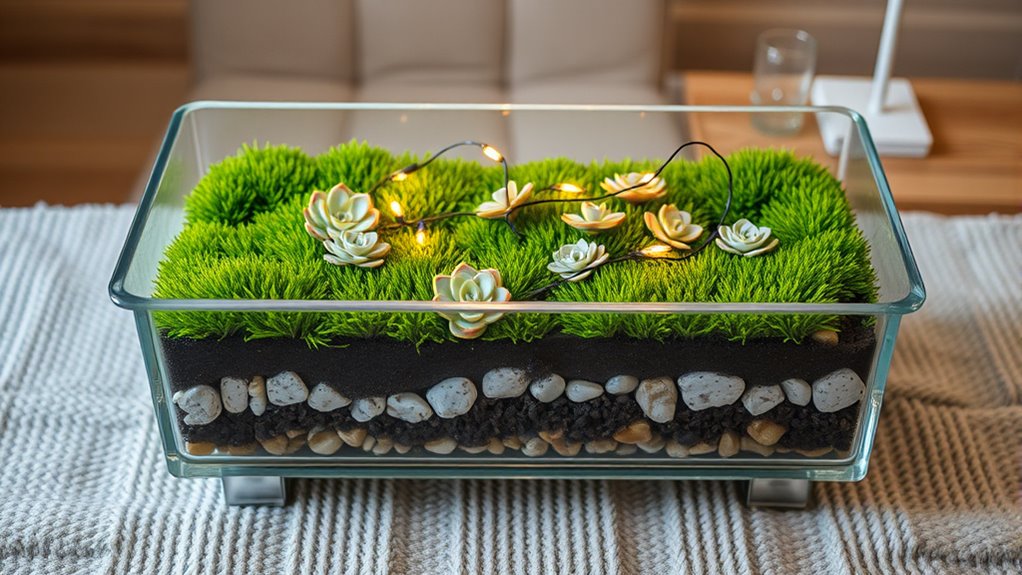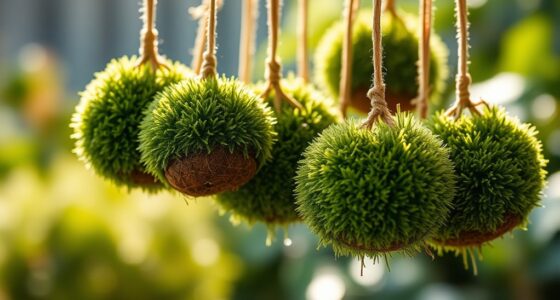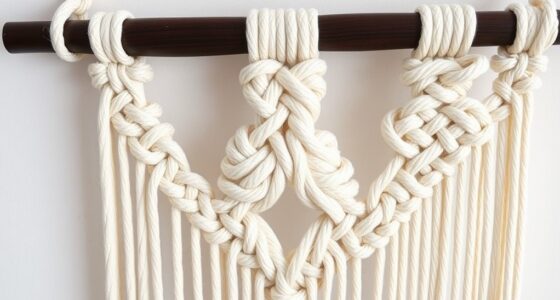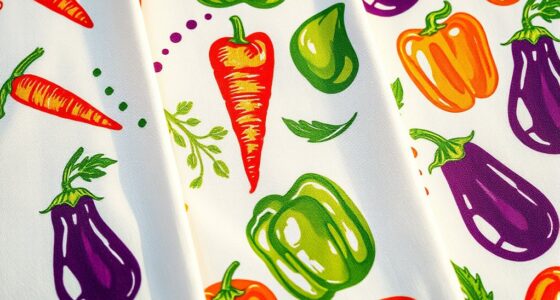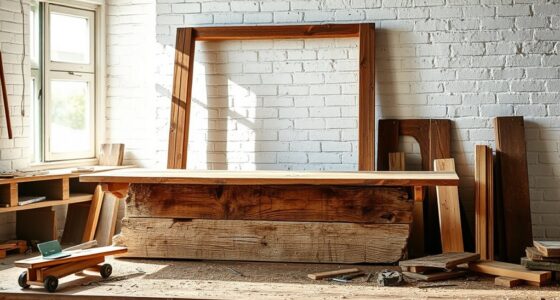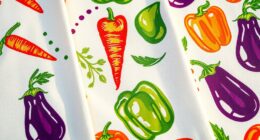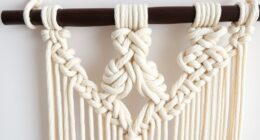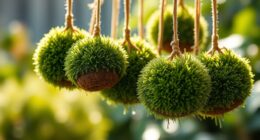To create a DIY terrarium coffee table, select a clear glass container with drainage holes and layer it with gravel, activated charcoal, and succulent soil. Arrange a variety of succulents in a balanced, natural way, placing taller plants in the back or center and shorter ones in front. Water sparingly, ensuring proper care and placement in bright, indirect light. If you keep experimenting, you’ll uncover tips to enhance your living decor under glass.
Key Takeaways
- Select a suitable glass container with drainage holes or add a drainage layer for excess water management.
- Choose a variety of succulents with different shapes, sizes, and colors for visual interest and texture.
- Arrange taller plants centrally or at the back, with shorter ones in front, for balanced and natural placement.
- Fill the container with well-draining succulent soil, layering gravel and activated charcoal for filtration and odor control.
- Place the finished terrarium on a bright, indirect light spot, water sparingly, and monitor for overwatering or dehydration.
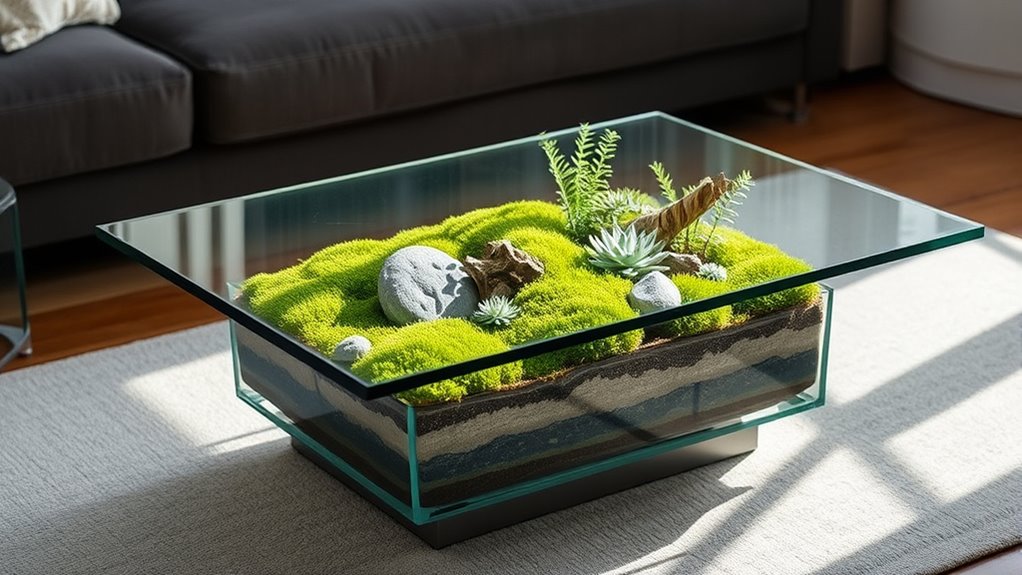
Creating your own DIY terrarium coffee table is a fun and rewarding project that adds a natural touch to any living space. One of the key elements to regard is your succulent arrangements. Succulents are perfect for terrariums because they require minimal watering and thrive in enclosed environments, making them ideal for a glass container. When planning your succulent arrangements, think about variety and texture. Mix different shapes, sizes, and colors to create interest and depth. You might include some rosette-forming succulents like echeveria alongside taller, spiky varieties such as aloe or agave. Grouping similar plants can create a cohesive look, but don’t hesitate to experiment with contrasting colors and forms for visual appeal.
Arrange varied succulents with texture and color for a stunning terrarium centerpiece
Choosing the right glass container is critical to your success. Your glass container choices should balance size, shape, and drainage options. Because succulents dislike excess moisture, opt for containers with drainage holes when possible. If your chosen glass vessel lacks drainage, you’ll need to create a drainage layer at the bottom using small pebbles or gravel. Above that, add a layer of activated charcoal to help filter the soil and prevent odors. Finally, fill the container with well-draining succulent soil, ensuring it’s loose enough to allow the roots to breathe. The transparency of glass lets you showcase the layers and the plants, creating a visually appealing centerpiece.
Once you’ve selected your container and arranged your succulents, it’s time to assemble your terrarium. Carefully place each plant into the soil, arranging them in a way that looks balanced and natural. You might choose to cluster taller plants at the center or toward the back, with shorter varieties in front. Use small tools like tweezers or chopsticks to position plants precisely without damaging their roots. After planting, give everything a gentle watering—remember, succulents need only a small amount of water at a time. Keep in mind that the glass walls will help retain moisture, so avoid overwatering.
Additionally, selecting the appropriate electric bike conversion kit can be a great way to enhance your outdoor experience if you plan to transport your DIY terrarium or simply enjoy a sustainable commute. To finish, place your DIY terrarium coffee table in a spot with bright, indirect light. Regularly check your succulents for signs of overwatering or dehydration. With a little care, your living decor will flourish under glass, creating a beautiful, low-maintenance centerpiece. Whether you’re displaying it in your living room or an entryway, your custom-made terrarium coffee table will not only enhance your space but also serve as a testament to your creativity and green thumb.
Frequently Asked Questions
What Are the Best Plants for a Terrarium Coffee Table?
When choosing plants for your terrarium coffee table, you want varieties that thrive in enclosed spaces. Succulent varieties are perfect because they require minimal water and add texture. Additionally, include air purifying plants like pothos or peace lilies to improve air quality. These plants stay small and manageable, creating a lush, vibrant display. With the right selection, your living decor will look beautiful and stay healthy under glass.
How Do I Maintain Humidity Levels Inside the Terrarium?
To maintain proper humidity levels inside your terrarium, focus on humidity control by regularly monitoring moisture. Use watering techniques like misting to keep the environment humid without over-saturating. Keep the glass cover slightly ajar for ventilation, allowing excess moisture to escape. If humidity drops, increase misting gently. Consistent attention to humidity control and appropriate watering guarantees your plants thrive in a healthy, balanced environment.
Can I Add Lighting to Enhance Plant Growth?
Think of your terrarium as a tiny ecosystem needing a gentle sunbeam. You can definitely add LED lighting or grow lights to boost plant growth inside your coffee table. These lights mimic natural sunlight, encouraging healthy development and vibrant foliage. Position the lights just above the plants, and set them on a timer to guarantee consistent light cycles. This way, your living decor stays lush and thriving under glass.
What Is the Average Lifespan of a DIY Terrarium Coffee Table?
The average lifespan of your DIY terrarium coffee table depends on your terrarium design and ongoing DIY maintenance. With proper care, such as controlling moisture and providing adequate light, your living decor can last several years. Regularly trimming plants and checking for mold or pests helps extend its life. Keep up with DIY maintenance, and your terrarium can remain a beautiful, thriving centerpiece for a long time.
How Do I Prevent Mold and Pests in My Terrarium?
Think of your terrarium as a tiny ecosystem that needs balance. To prevent mold and pests, guarantee good air circulation by opening the lid occasionally. Maintain a regular cleaning routine, removing dead leaves and excess moisture, which act like a shield against unwanted invaders. These simple steps help keep your living decor healthy and vibrant, just like a thriving miniature garden that’s cared for with love and attention.
Conclusion
Now, your DIY terrarium coffee table becomes a tiny universe, a glass-encased garden where nature’s whispers dance. With every plant and pebble, you’ve crafted a living mosaic that breathes life into your space. It’s more than furniture—it’s a enchanting story under glass, a miniature world you created with your own hands. So sit back, relax, and enjoy the lush, vibrant oasis that’s now the heart of your living room.
